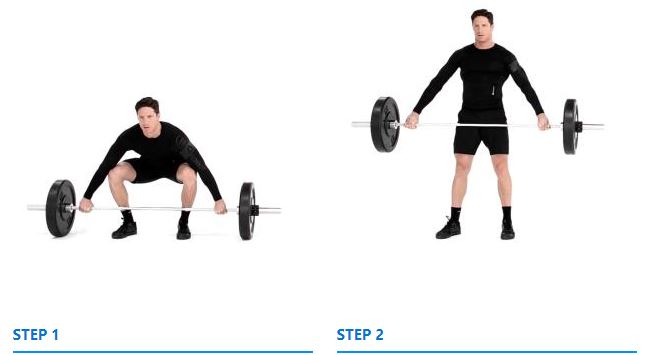Muscles Targeted:
A properly performed deadlift will activate almost every muscle in your body from your toes on up to the muscles that contract your ears if the weight is heavy enough. The prime movers in the deadlift are the posterior chain. For those of you who are unfamiliar with the posterior chain, that includes your erector spinae, gluteus maximus and hamstrings. Those muscles work together to do the heavy lifting. Your forearms, back and trapezius muscles work indirectly to stabilise the weight as it is being lifted off the floor.
Why This Exercise is Important:
There is no other exercise that activates the body directly or indirectly as the barbell deadlift. With so many muscle groups involved, even a novice lifter is usually capable of putting up heavy weights very quickly and stimulating mass building second to none. The simplicity of the movement makes it a good fit for lifters of all age ranges or fitness levels. Few exercises mirror real life activities as closely as the deadlift. Regular deadlifts can help prevent throwing out your back when bending over to lift something off the ground. Above all of that, the deadlift is just plain fun. What other better way is there to tap into our primal nature than to pick heavy stuff up off the ground?
Exercise Instructions:
- Place a barbell on the floor at your feet just outside of a squat rack area.
- Keeping your back straight, squat down and grasp the barbell with both hands using an overhand grip just beyond shoulder width apart.
- In one motion, lift the barbell by using your legs so that you end up standing up straight.
- Be sure to keep your arms hanging straight down so that the barbell ends up being just about mid-thigh level.
- Slowly return to the start position and repeat.
Things To Avoid:
When you’re deadlifting there are several things that can go wrong and possibly lead to injury. Stay away from rounding your back when doing deadlifts. Keep your head up and shoulders back when pulling. Don’t allow your hips to go up first. Let your shoulders start the movement and then pull up with your hips. If you deadlift with a mixed grip, then you need to change your grips up frequently to prevent any muscle imbalances. Keep the bar close to your body or you will lose a lot of power when deadlifting.
Reps and Sets:
Barbell deadlifts are best performed for lower rep ranges. The longer rep sets will usually exhaust your forearms before you have tired your posterior chain. Strengthening your forearms should be a secondary benefit to the deadlift. Deadlifts will work best when worked in sets of 3-5 and for reps of 1-5. Occasionally mixing in sets of higher reps in the 5-10 range may work as well for adding mass. If higher reps are used then adjust the sets down to 1-3 sets.
Other Exercises To Use:
While nothing can replace deadlifts, you can mix up your routine by adding some of these exercises. Barbell squats have a high carryover to deadlift strength. Barbell rows will strengthen your upper back similarly to deadlifts, but fail to target your lower body. Power cleans target the same muscle groups but work the body explosively. Throw in the stiff leg Romanian deadlift every now and then to really focus on stretching the hamstring muscle groups.
I hope you’re considering adding deadlifts to your exercise routine now. If you’re already doing deadlifts, then I hope you do them more frequently. No other exercise comes close to hitting as many muscle groups at one time as they do. As always start light and learn the form and then add weight to the bar.


